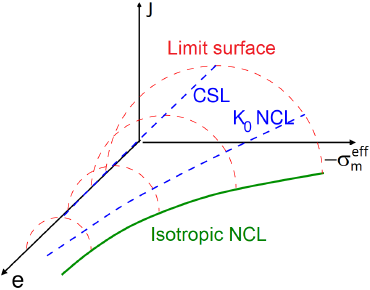Critical state models
The critical state models ground on the concept of a critical void ratio state at which an unlimited shear straining can take place without altering the current mean stress and the corresponding void ratio (volumetric strain).
These models will prove useful particularly in tasks, where the prediction of settlement plays an important role. They capture a number of soil properties, which can hardly be addressed by simplified plasticity models including stress dependent stiffness, soil response depending on porosity, nonlinear behavior inside the yield surface, prediction of dilatancy and limiting critical state without independently introducing the dilatancy angle, possibility to define a limit surface (state boundary surface) in the stress and porosity space, see the figure below, where CSL stands for the critical state line, NCL denotes the normally consolidated soil while assuming K0 consolidation (K0 = K0NC, where K0NC is the coefficient of lateral earth pressure at rest of a normally consolidated soil) or isotropic consolidation (K0 = 1), e is the void ratio, σm is the mean stress and J is the equivalent measure of the vector of deviatoric stress components.

The class of critical state models include the Modified Cam-clay, Generalized Cam-clay, Hypoplastic clay models. The models based on the theory of plasticity also fall into the group of elastic-plastic material models with hardening and softening.